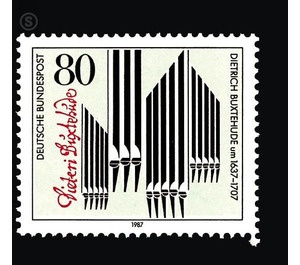350th birthday of Dietrich Buxtehude - Germany / Federal Republic of Germany 1987 - 80 Pfennig
Theme: Art & Culture
| Country | Germany / Federal Republic of Germany |
| Issue Date | 1987 |
| Face Value | 80.00 |
| Color | black white |
| Perforation | K 14:13 3/4 |
| Printing Type | 3-color offset |
| Stamp Type | Postage stamp |
| Item Type | Stamp |
| Chronological Issue Number | 1196 |
| Chronological Chapter | GER-BRD |
| Michel ID | BRD 1323 |
| SID | 498075 |
| In 44 Wishlists | |
The birthday of Dietrich Buxtehude is unknown and the place of birth is controversial. The German musicologists Wilhelm Stahl and Friedrich Blume consider the Schleswig-Holstein Bad Oldesloe the most likely place, while the Danish researchers consider Helsingborg to be the most acceptable. Both places were under Danish rule in the 17th century. Even the birth year can not be determined correctly. It is somewhat vague from a note in the Baltic newspaper Nova literaria Maris Balthici, which reports in the July 1707 issue on the death of Buxtehude: "Patriam agnoscit Daniam, ande in nostras delatus oras septuaginta circiter vivendo annos implevit." That is, Dietrich Buxtehude recognized Denmark as his homeland, and it can be understood both Bad Oldesloe in Holstein, where his father Johannes is detectable until 1638, and Helsingborg, where the father repaired an organ in 1641. The record that Dietrich Buxtehude was about 70 years old at the time of his death suggests that he was born in 1637. In any case, he spent his youth in Helsingborg, where his father was organist at the St. Olaus Church by 1642 at the latest. After attending the Latin school and teaching his father was Dietrich 1657 or 1658 organist at St. Mary's Church in Helsingborg. In 1660 he changed over the Sound to Helsingör. Due to the friendship with the Swedish postmaster tailor Buxtehude made acquaintances to the Swedish court Kapellmeister Gustaf Düben in Stockholm, to the organists in Hamburg, especially Johann Adam Reinken, and must have been known in 1667 with the Marienorganisten Franz Tunder, after his death In November 1667 Buxtehude applied for the post of Marienorganisten in Lübeck. After consent to the marriage with the daughter Anna Margareta of his predecessor, he received in 1668 the office of Marienorganisten and at the same time the master craftsman, the accounting and administrative officials, the St. Mary's Church. As an organist, he had the task to accompany the service in auditions and re-enactments, but not the church singing, which was not common then. For this he composed his preludes, fugues and choral arrangements for the organ, of which 90 pieces have been preserved. His 112 cantatas seem to have been intended more for concert-like performances, in the smaller occupations intended for home use. An important part of his work was the "Abendmusiken", which he wrote for the last two Trinitatissonntage and the 2nd to 4th Advent and performed in his own event. There is no music from them. Some of the large cantatas are accepted as parts of evening music. Two printed collections of 7 trio sonatas each, Hamburg 1694 and 1696, were used for home and also as communion music. An early manuscript with works for harpsichord and 7 wedding arias, preserved in print, complete the accessible work of Buxtehude. From his cantatas and organ pieces as well as the evening music Buxtehude large losses must be assumed because of the followers of ignorance, many documents have been burned or squandered as waste. However, the resulting work shows him as the creator of the North German cantata and outstanding organ composer. "The thematic-systematic index of the musical works of Dietrich Buxtehude", published in 1st edition of Georg Karstädt in Wiesbaden 1974, in 2nd edition 1984, shows with 275 BuxWV numbers numerous works from all genres and shows that the Buxtehude After the Second World War experienced a significant advance, which will receive a further boost in the commemorative year of 1987. American, Danish, Italian, Swedish and German musicologists are excellently involved. (Text: Dr. Georg Karstädt, Lübeck)
| Condition | Name | In Stock | Price | Price + Shipping | Store | |
|---|---|---|---|---|---|---|
 | Unmounted Mint ** | 350th birthday of Dietrich Buxtehude - Germany / Federal Republic of Germany 1987 - 80 Pfennig | 10 | US $0.761 | US $4.01 |  FILATELIELOKET (0) FILATELIELOKET (0)Shipping US $3.25 Minimum Order US $2.72 |


